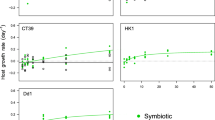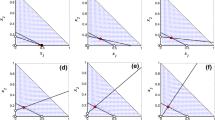Abstract
Host and algal symbion growth can be described by an iterative model which incorporates utilization efficiencies of host and symbiont. This model predicts that, with input of organic matter to the host and at very low host and algal utilization efficiences coupled with efficient recycling of nutrients between the host and symbionts, production of organic matter by the system can be increased by 2–3 orders of magnitude over that of a system comprised of only autotrophs and heterotrophs. Energy available for growth and respiration by the host is 1–2 orders of magnitude over that available to a heterotroph without symbionts. Algal symbiosis is highly advantageous in oligotrophic environments where radiant energy is abundant, growth-limiting nutrients are scarce and only concentrated in organic matter, and much energy must be expended to capture that organic matter.
Similar content being viewed by others
Literature Cited
Broeker, W. S.: Chemical oceanography, 214 pp. New York: Harcourt Brace Jovanovich, Inc. 1974
Conover, R. J.: Transformation of organic matter. In: Marine ecology, Vol. IV, Dynamics, pp 221–499, Ed. by O. Kinne. New York: Wiley-Interscience 1978
Goreau, T. F., N. I. Goreau and C. M. Yonge: Reef corals: autotrophs or heterotrophs? Biol. Bull. 141, 247–260 (1971)
Hannon, B.: The structure of ecosystems. J. Theor. Biol. 41, 535–546 (1973)
Holt, C. von and M. von Holt: Transfer of photosynthetic products from zooxanthellae to coelenterate hosts. Comp. Biochem. Physiol. 24, 73–81 (1968)
Knopp, K.: Theory and application of infinite series, 563 pp. New York: Hafner Publishing Company 1971
Lee, J. J.: Towards understanding the niche of the foraminifera. In: Foraminifera, Vol. I, pp 207–260. Ed. by R. H. Hedley and C. G. Adams. London and New York: Academic Press 1974
Lee, J. J. and W. A. Mullet: Trophic dynamics and niches of salt marsh foraminifera. Am. Zool. 13, 215–223 (1973)
Muller, P. Hallock: Sediment production and population biology of the benthic foraminifer Amphistegina madagascariensis. Limnol. Oceanogr. 19, 802–809 (1974)
Muscatine, L.: Glycerol excretion by symbiotic algae from corals and Tridacna and its control by the host. Science, N. Y. 156, 516–519 (1967)
Muscatine, L.: Nutrition of corals. In: Biology and geology of coral reefs, Vol. II; Biology 1. pp 77–115. Ed. by O. A. Jones and R. Endean. New York: Academic Press 1973
Muscatine, L., S. J. Karakashian and M. W. Karakashian: Soluble extracellular products of algal symbiosis with a ciliate, a sponge, and a mutant hydra. Comp. Biochem. Physiol. 20, 1–12 (1967)
Muscatine, L. and J. W. Porter: Reef corals: mutualistic symbioses adapted to nutrient-poor environments. BioScience 27, 454–460 (1977)
Raymont, J. E. G.: Plankton and productivity in the oceans. 660 pp. New York: Perganon Press 1963
Ross, C. A.: Biology and ecology of Marginopora vertebralis (Foraminiferida), Great Barrier Reef. J. Protozool. 19, 181–192 (1972)
Trench, R. K.: The physiology and biochemistry of zooxanthellae symbiotic with marine coelenterates. I. The assimilation of photosynthetic products by two marine coelenterates. Proc. Roy. Soc. London (B) 177, 225–235 (1971)
Yonge, C. M.: Studies on the physiology of corals. I. Feeding mechanisms and food. Great Barrier Reef Exped., 1928–29, Sci. Repts. 1, 15–57 (1930)
Yonge, C. M.: Origin and nature of the association between invertebrates and unicellular algae. Nature, Lond. 134, 12 (1934)
Author information
Authors and Affiliations
Additional information
Communicated by J. Lawrence, Tampa
Rights and permissions
About this article
Cite this article
Hallock, P. Algal symbiosis: A mathematical analysis. Mar. Biol. 62, 249–255 (1981). https://doi.org/10.1007/BF00397691
Accepted:
Issue Date:
DOI: https://doi.org/10.1007/BF00397691




